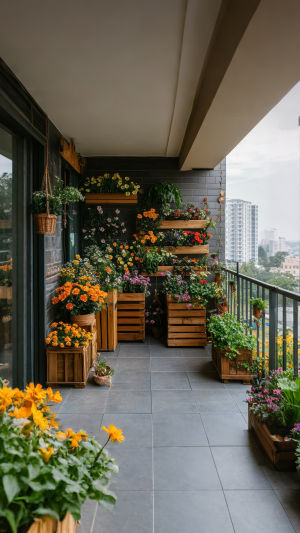Do you have a small balcony but dream of turning it into a lush green space? We totally understand! Together, we'll explore practical and easy-to-follow methods to grow beautiful flowers and plants even in limited spaces.
Whether you're a beginner or have some gardening experience, this guide will help you create a cozy, green paradise right outside your door. Ready to get started?
<h3>Choosing the Right Plants for Your Balcony</h3>
Since balcony space is usually limited, selecting plants that fit well is key. We recommend herbs like basil, thyme, and mint because they have shallow roots and don't require large pots. These herbs not only add greenery but can also be used fresh in your cooking, making your garden both beautiful and useful.
For flowers, consider compact varieties like pansies or petunias that thrive in pots and bloom abundantly. Succulents and small ferns are also excellent for low-maintenance greenery.
<h3>Picking Suitable Containers and Arrangement</h3>
We find that using small to medium-sized pots helps manage space better. Separate pots for different plants allow us to move them easily and provide tailored care. Hanging pots or vertical planters are fantastic space-savers and add a dynamic look to the balcony. Make sure your containers have good drainage holes to prevent waterlogging, which can harm roots. Grouping plants according to their sunlight and water needs simplifies daily care.
<h3>Sunlight and Watering Essentials</h3>
Most balcony plants need at least 4 to 6 hours of sunlight. We should observe which parts of the balcony get the most sun and place sun-loving plants there. For shaded areas, plants like ferns or certain begonias do well. Because soil in pots dries faster than in the ground, watering frequency is crucial. Check soil moisture daily—sometimes watering once or twice a day is needed, especially in summer. Avoid overwatering by ensuring excess water drains away freely.
<h3>Soil and Fertilization Tips</h3>
Using high-quality potting soil designed for container plants is essential for good growth. We suggest mixing in organic compost or slow-release fertilizers to provide steady nutrients. Regular feeding during the growing season keeps plants healthy and encourages blooming. For edible plants, organic fertilizers are best to keep them safe for consumption. Remember to refresh the soil every year or repot plants to avoid nutrient depletion.
<h3>Maximizing Space with Vertical and Hanging Gardens</h3>
We love vertical gardening because it turns walls into green canvases. Installing shelves, hanging baskets, or pocket planters lets us grow more plants without taking up floor space. Climbing plants like ivy or morning glory can add lushness and privacy. This approach also makes watering and maintenance easier since plants are grouped and accessible.
<h3>Protecting Plants from Wind and Weather</h3>
Balconies can be windy and exposed, which stresses plants. We recommend placing windbreaks like bamboo screens or using heavier pots to prevent tipping. During extreme weather, moving delicate plants indoors or to sheltered spots helps them survive. Mulching the soil surface reduces moisture loss and keeps roots cooler in hot weather.
<h3>Enjoying the Process and Sharing Your Green Space</h3>
Gardening on a balcony is a rewarding hobby that connects us with nature daily. We encourage you to experiment with different plants and arrangements, learning from each season. How about sharing photos or tips with us? Let's inspire each other to create beautiful, green sanctuaries no matter the size of our space.
Together, we can transform even the smallest balcony into a vibrant, refreshing oasis. Happy gardening!
This article draws on expert advice and practical experience to help you build a thriving balcony garden that suits your lifestyle and space.





